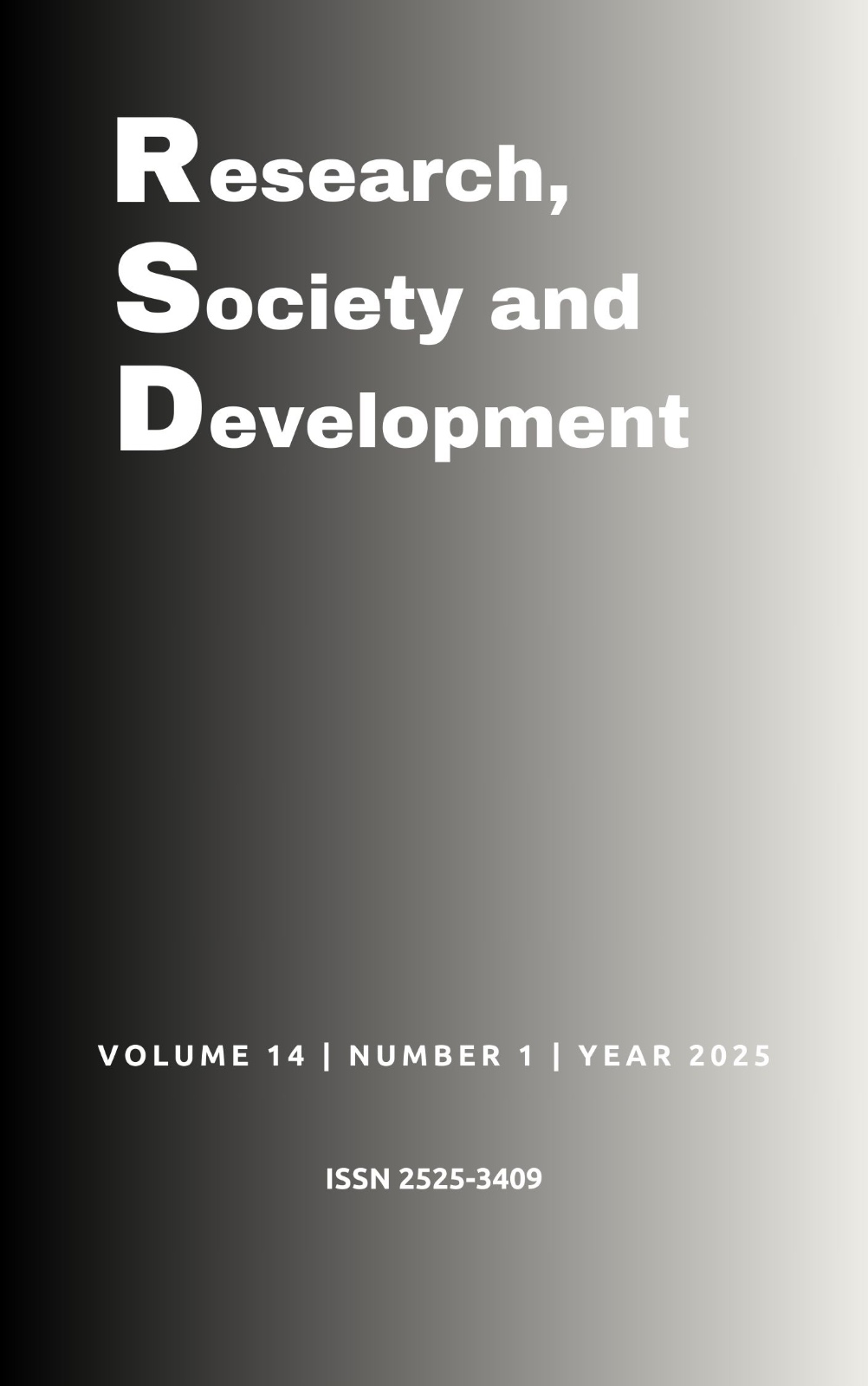Survey of foliar diseases in vegetables from the teaching Project of IFTM – Campus Uberlândia - MG
DOI:
https://doi.org/10.33448/rsd-v14i1.48145Keywords:
Incidence of plant diseases; Cercospora spp.; Radish; Tomato; Lettuce.Abstract
Vegetable production in Brazil faces significant challenges, including foliar diseases, which affect plant quality and productivity. The accurate identification of foliar diseases helps in the development of control strategies that minimize economic and environmental impacts. The objective of the research was to evaluate the incidence of the main foliar diseases that affect vegetables grown in the IFTM teaching project, Uberlândia-MG campus. The evaluations were carried out between the months of October and December 2023. The crops evaluated were: lettuce, beetroot, carrot, cucumber, okra, radish, arugula and tomato. The plants were placed in the field in beds in DBC and data on the incidence of foliar diseases were analyzed and allowed the identification of the most significant diseases and the relationship between climatic conditions and the incidence of pathogens. Radish was the most evaluated crop, 23% of the total. This significant number may indicate the focus on short-cycle vegetables and also the economic and food relevance of radishes in the study region. Cucumber, with only 4% of evaluations, had low representation, which may indicate that this crop is more common in protected crops. Leaf spot, caused by the fungus Cercospora sp., was the one with the highest incidence among the crops analyzed. The work addressed the challenges faced in vegetable production in an integrated and practical way, highlighting the importance of sustainable strategies to reduce diseases and also economic and environmental impacts.
References
Alexopoulos, C. J.; Mims, C. W. & Blackwell, M. (1996). Introductory Mycology. Wiley.
Alves, Elvis et al. (2017). Determinação do coeficiente de cultivo para a cultura do rabanete através de lisimetria de drenagem. Irriga, 22(1), 194-203.
Aydin, Mehmet Hadi. (2022). Rhizoctonia solani and its biological control. Türkiye Tarımsal Araştırmalar Dergisi. 9(1), 118-135.
Barbosa, K.; Rodrigues, K. & Cabral, C. (2023). Performance de biofungicidas em doenças foliares de final de ciclo da soja (AGRONOMIA). Repositório Institucional, 2(1).
Carisse, Odile. (2016). Epidemiology and Aerobiology of Botrytis spp. Botrytis–the Fungus, the pathogen and its management in agricultural systems, 127-148.
Fajardo, TVM. (2015). Controle de doenças causadas por vírus. https://www.alice.cnptia.embrapa.br/alice/handle/doc/1027860?mode=simple.
Fonseca, Daniely et al. (2018). Aplicação da pesquisa operacional para o desenvolvimento local: uma alternativa para produtores de hortaliças por meio da otimização do processo produtivo. Encontro Internacional de Gestão, Desenvolvimento e Inovação (EIGEDIN), 2(1).
Fry, W. E. (2016). Phytophthora infestans: Novas ferramentas (e antigas) levam a uma nova compreensão e gerenciamento de precisão. Annual Review of Phytopathology, 54(1), 529-547.
Harms, M. G. et al. (2015). Influência da densidade de plantas e do uso de fungicida nas doenças foliares e na produtividade de cebola. Horticultura Brasileira, 33, 203-207.
Marin, V. R. et al. (2019). Recent advances in the biocontrol of Xanthomonas spp. World Journal of Microbiology and Biotechnology, 35(5), 72.
Medeiros, A. C. et al. (2015). Métodos de inoculação de Rhizoctonia solani e Macrophomina phaseolina em meloeiro (Cucumis melo). Summa phytopathologica, 41(4), 281-286.
Moraes, S.A. de. (2007). Quantificação de doenças de plantas. Artigo em Hypertexto. http://www.infobibos.com/Artigos/2007_1/doencas/index.htm
Morales-Soto, A. & Lamz-Piedra, A. (2020). Métodos de mejora genética en el cultivo del frijol común (Phaseolus vulgaris L.) frente al Virus del Mosaico Dorado Amarillo del Frijol (BGYMV). Cultivos Tropicales, 41(4).
Paraginski, J. A. et al. (2022). Severidade de doenças fúngicas foliares e desfolha da soja sob densidades de semeadura. Agrarian, 15(55), 14833-14833.
Patriarca, A. (2016). Alternaria in food products. Current Opinion in Food Science, 11, 1-9.
Pereira A. S. et al. (2018). Metodologia da pesquisa científica. [free e-book]. Santa Maria/RS. Ed. UAB/NTE/UFSM.
Pires, T. P. et al. (2015). Períodos de controle das plantas espontâneas em sistema de cultivo orgânico de quiabo. Cadernos de Agroecologia, 10(3).
Ramírez-Vargas, C. (2019). Extracción de nutrientes, crecimiento y producción del cultivo de pepino bajo sistema de cultivo protegido hidropónico. Revista Tecnología en Marcha, 32(1), 107-117.
Roque, I. A. et al. (2024). Cultivo de quiabo sob irrigação com água salina e aplicação foliar de peróxido de hidrogênio. Revista Ambiente & Água, 19, 2980.
Würz, D. A. et al. (2020). Aplicação foliar de silício reduz a ocorrência de doenças fúngicas na cultura do morangueiro. Revista Eletrônica Científica da UERGS, 6(2), 150-154.
Downloads
Published
How to Cite
Issue
Section
License
Copyright (c) 2025 Felipe Ricardo Rocha; Juliana Araújo Santos Martins

This work is licensed under a Creative Commons Attribution 4.0 International License.
Authors who publish with this journal agree to the following terms:
1) Authors retain copyright and grant the journal right of first publication with the work simultaneously licensed under a Creative Commons Attribution License that allows others to share the work with an acknowledgement of the work's authorship and initial publication in this journal.
2) Authors are able to enter into separate, additional contractual arrangements for the non-exclusive distribution of the journal's published version of the work (e.g., post it to an institutional repository or publish it in a book), with an acknowledgement of its initial publication in this journal.
3) Authors are permitted and encouraged to post their work online (e.g., in institutional repositories or on their website) prior to and during the submission process, as it can lead to productive exchanges, as well as earlier and greater citation of published work.

